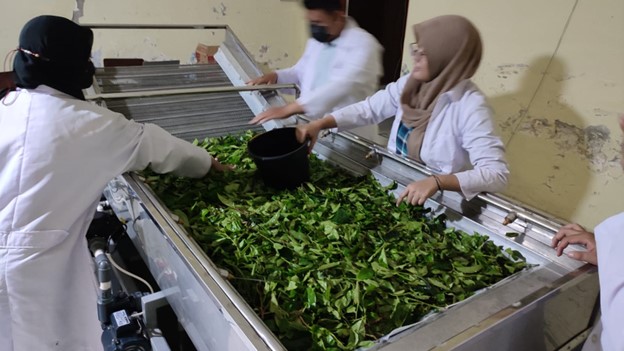SEMARANG–Various food mixtures with green tea (Green Tea) such as donuts, ice cream, all types of bakery (bread) to martabak have been found in Indonesia today. Processed food products mixed with green tea are intended to be healthy when consumed and can even reduce fat content. We all know that green tea contains antioxidants, anti-inflammatory and anti-cancer properties that are good for maintaining a healthy body, thus providing benefits such as preventing heart disease and stroke, inhibiting the growth of cancer cells, preventing diabetes and even weight loss and other benefits. This is in accordance with the realization of the 17 indicators of the Sustainable Development Goals (SDGs) which are ‘Healthy and Prosperous Life’.
The fact is that food products that have been mixed with green tea have side effects when consumed too much, such as causing a burning feeling in the stomach and even not good for people with acute ulcers. This is because there is a caffeine component in green tea which is not good for consumption in excess, even not good for consumption in children and the elderly. Based on the observations of five lecturers from the Vocational College of Diponegoro University (UNDIP) they investigated how the effects of caffeine from green tea could be minimized. The five lecturers who conducted the research were M Endy Yulianto, ST., MT, Dr Eng Vita Paramita, ST., MM., M.Eng, Dr. Ir Eflita Yohana, MT and Dr Dada Rohdiana. The research focused on “Commercialization of Caffeine-Free Green Tea Monopolyphenol Products as Functional Food Incorporation Through Enzymatic Inactivation Techniques” which aims to separate green tea from its caffeine content component.
“In addition to the caffeine content in green tea, there is also a fairly high content of tannins and polyphenols. The content of tannins and polyphenols is what has many benefits when consumed without side effects such as preventing cancer, heart disease, stroke, diabetes and others. This is the focus of the friends in this research in the hope of producing quality green tea according to the realization of the 17 indicators of the 3rd Sustainable Development Goals (SDGs), namely ‘Healthy and Prosperous Life’. So that later when functional food is made, anyone can eat it without worrying about side effects,” said M Endy, Friday (1/04/2022).
Furthermore, one of the students named Palupi Diah Utami who participated in this study said, “This activity is very useful during the COVID-19 pandemic when lectures are held online. With the existence of lecturer research involving students, increasing knowledge, experience, and training in collaboration”. In the separation process, it was revealed that the development of green tea powder products with low caffeine content was carried out through enzymatic inactivation by applying the blanching process and applying the nanoencapsulation process of caffeine-free green tea powder and high polyphenol content using liposome biopolymer by applying a spray drying process. “The separation process for caffeine-free green tea production consists of blanching, drying, grinding, brewing, centrifugation, filtration, concentration, nanoencapsulation and spray drying,” said Endy.

After the separation of green tea from caffeine content has been carried out, green tea products will be commercialized due to their high potential considering that the global market value of nanomaterial products and their incorporated products is expected to increase by 50 percent. Commercialization will be carried out in collaboration with a prospective and competitive green tea industry, namely the Gambung Tea and Quinine Research Center (PPTK) in South Bandung. “Alhamdulillah, through the Institute for Research and Community Service or LPPM Undip Vocational College, we are able to cooperate with the PPTK Gambung green tea industry in South Bandung. It is hoped that from this collaboration, green tea production which has been separated from caffeine can then be commercialized to the public, so that next year it can be produced and marketed directly to the public,” he hoped.
In the management of PPTK Gambung in South Bandung, it was known that there were doctors, including a pharmacist. The person concerned becomes a partner for the benefits of the caffeine component in green tea which has been separated to be produced to be used as medicines that also have many benefits such as memory enhancement, antidiabetic and even preventing hair loss. In collaboration with PPTK Gambung, research was also carried out on all aspects of the tea business and industry, including plant breeding, plant protection, soil and fertilization, tea garden management, processing and quality improvement, diversification of finished products, socioeconomics, trade, policies, and institutions. “Of course, this is very helpful and supports the results of our hard work in conducting research, so that caffeine-free green tea nano polyphenol products as functional food incorporations can really be felt by the public, especially safety consumption issue for everyone,” he said.


Recent Comments